By Philip Cauchi
Question - I’m having trouble with my two forwards when it comes to defending. What responsibilities should I give them when we have lost possession?
Forwards play a very important role to help the team recover the ball in the phases of non-possession. The first principle that I demand from all my players is that whoever loses the ball, he/she should be the first to immediately apply pressure and try to recover it back. When the opponents are constructing play from a low build-up (from inside the defending third), the two forwards are the first line of pressure. Their position is imperative in inviting the opponents to play the ball towards their weaker zones or where we are the strongest.
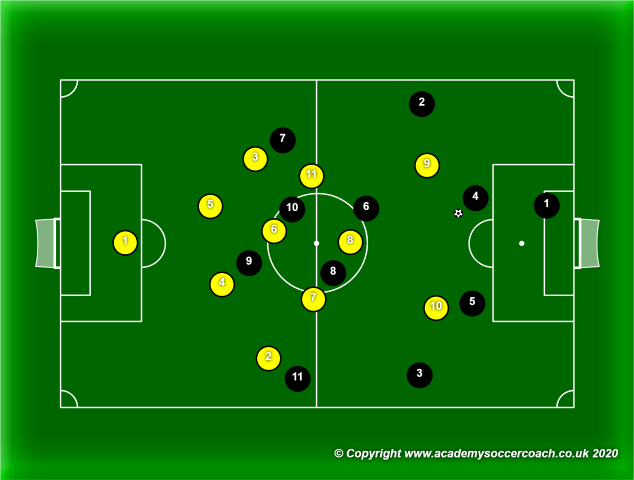
Figure 1 - The forwards (yellows 9 and 10) split up their positions to invite play towards the middle where we have a numerical superiority. The position of the forwards prevent the opponents to play towards the flanks.
A very important part that the two forwards might play during the ball recovery phase (opponents in possession) is to mark the deep lying playmaker. This player is normally the most tactically intelligent player in the team and he/she can initiate the construction of dangerous attacks. One of the two thus drops in order to deny the deep lying playmaker the possibility of receiving the ball and construct play.
The pair of forwards should never detach from the rest of the team. As an example if the ball is in midfield, they can help in putting pressure on the opponent with the ball from behind forcing him/her to commit a mistake. Another important movement that the forwards can do is to mark potential ball receivers, especially if the opponents are in a pressured situation.
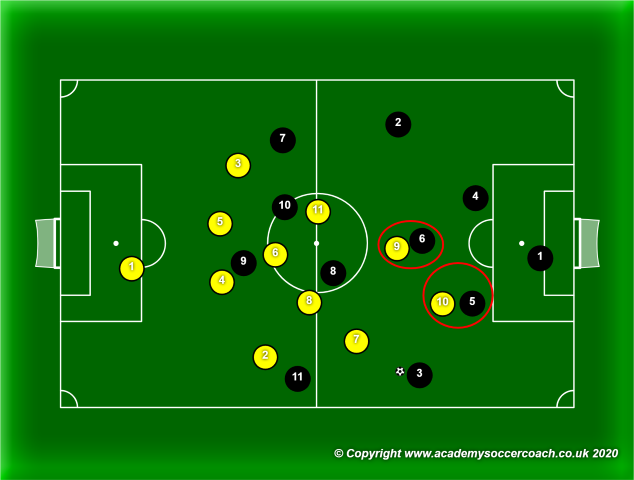
Figure 2 – The two forwards position themselves to mark potential ball receivers and thus remove the option for the opponents to switch play. The pitch has thus became smaller for the opponents.
To develop the behaviour of the two forwards to participate more effectively in the ball recovery phase I suggest using positional games and small-sided games. In these training situations we will design contexts in which the effective collective behaviour to recover the ball emerges. I also find rewards very effective in shaping a behaviour as they motivate the players in training. Over time these movements will become habits, and the forwards will effectively carry them out without thinking.
In summary during the phase of non-possession the two forwards can work together to:
1. Make play predictable into zones where we have a higher chance of recovering the ball.
2. Initiate pressing actions by forcing play on the flanks and making the pitch small through their movement.
3. Prevent a switch of play and deny escape routes from pressing situations by marking potential ball receivers.
4. Mark the opposition’s deep lying playmaker.
Suggested training situations:
4v2: Forwards pressing rondo.
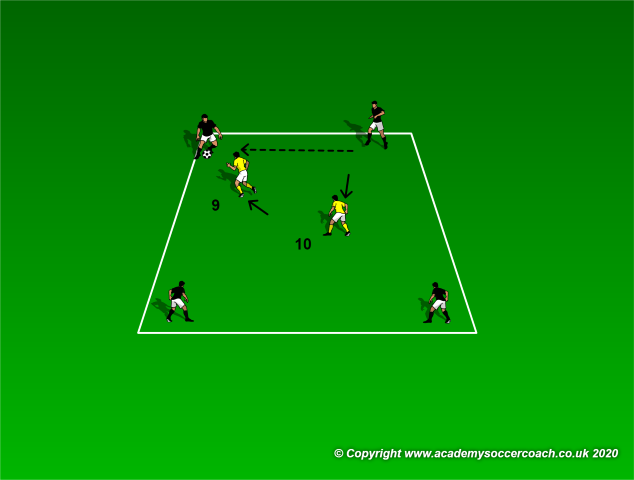
Area: 12 yards by 10 yards.
Players: Three groups of two players each.
Preparation: Two pairs start as attackers while the third pair play as defenders. One of the attacking players start with the ball.
Description: The pair scores a point for every ball intercepted within a thirty second period. The attackers earn a point for every eight consecutive passes made. Pairs compete with each other of who earns the most points.
Coaching outcomes:
1. The defender (forward) closest to the ball applies pressure while the other covers.
2. The defenders (both forwards) work to cut off forward passing options.
3. Timing to apply pressure on the ball: on a bad first touch by the receiver, the receiver lowers his head, the receiver receives the ball with his/her back to the game, and on a slow and short pass.
Variation: The defenders (both forwards) score on a mini goal positioned one yard behind the end line at both ends.
4v4+3 Positional Game
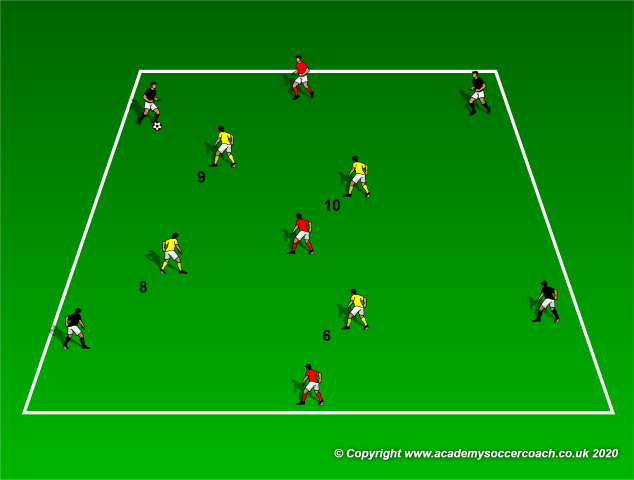
N.B. The yellow 9 and 10 are the forward we want to coach during the non-possession phase.
Area: 25 yards by 15 yards.
Players: Two teams of four players each plus three neutral players.
Preparation: One team starts as attackers with the ball while the other as the defending team. The three neutral players are positioned in the middle vertical lane.
Description: Teams aim to score ten consecutive passes. If the defending team wins possession they swap places with the attacking team and quickly form an attacking shape as in a moment of positive transition. The attacking team also score an extra point if they successfully pass the ball through the defence.
Coaching outcomes:
1. Aim to win the ball immediately at the moment it is lost.
2. If this cannot be achieved regroup in a compact unit.
3. Force play towards the flanks (the two forwards 9 and 10).
4. Time pressing actions together as a unit when the ball is enroute from one attacker to another.
Variation: Have two mini goals positioned at each end near the corners. Make play directional by having one team defending two goals on one end and attack the opposite two. The other team does the same but in the opposite direction.
GK+5 v GK+5 plus 1 neutral small sided game
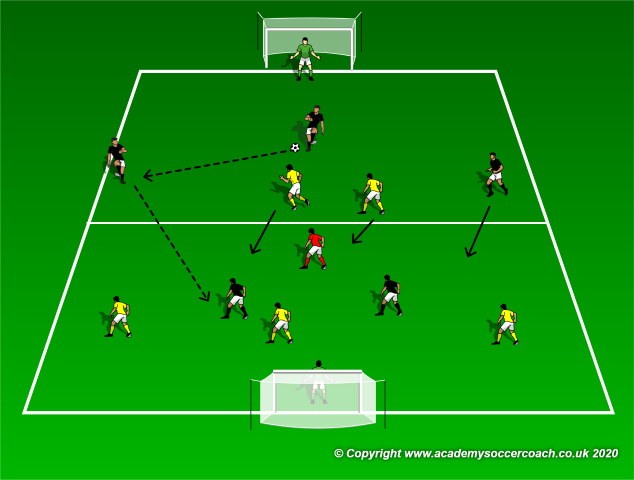
Area: 40 yards by 30 yards which is divided into two vertical halves.
Players: Two teams of five players each plus one neutral player.
Preparation: Both teams start from their own half as in regulation soccer. Both teams line up in a 1-3-2 formation.
Description: Normal game except that there are no throw-ins or corner kicks. Play always starts from the goalkeeper of the team in possession of the ball. Even if a goal is scored, play starts from the goalkeeper. This rule is in effect so that two forwards are confronted with situations of defending from the front regularly. If the defending team’s forwards recover the ball and score, it equals three points. If the neutral player (deep lying playmaker) scores it equals two points, therefore the two forwards in the defensive phase need to cut the passing lane towards him/her by having one of them drop to mark him/her. One player from each team plus the neutral player can move into the attacking half of the opponents when in possession of the ball.
Coaching outcomes:
1. Aim to win the ball immediately at the moment it is lost.
2. If this cannot be achieved regroup as a compact unit.
3. Force play towards the flanks (the two forwards).
Variation: Remove the neutral player and have one of the two teams playing in a numerical advantage. How will the opposite team cope when playing in a numerical disadvantage? What role do the strikers play in their strategy?
By Philip Cauchi


